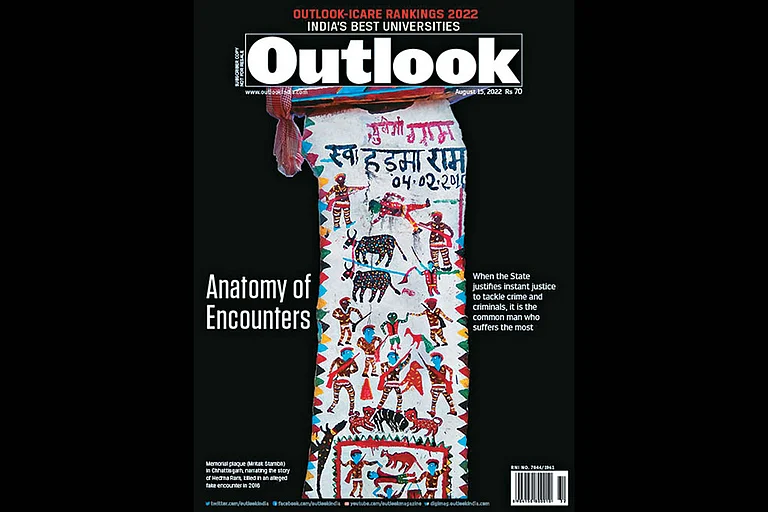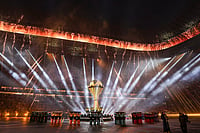FILMMAKER Benoy K. Behl is all set to electrify the art history world, by revealing not mere images but a whole new world. That of 11th century Buddhist Ladakh. Over the last four years Behl, together with comrade-in-arms and fellow researcher/filmmaker Sangitika Nigam, has roamed across the rugged roof of the world, photographing and documenting no less than 51 remote, often inaccessible, 11th to 17th century monasteries.
These are probably the last repositories and relics of a pristine Buddhism that once flourished in this region. And what remain of the original 108 that the Buddhist king Yeshe O established in the early 11th century. Never studied, invariably neglected, often in a state of appalling disrepair, these monasteries house Buddhist treasures, artefacts, murals never before seen, far less studied, by the outside world.
"These monasteries," says Behl, "are as much a document of trans-Himalayan Buddhism as they are of the never minutely examined Kashmiri Buddhist tradition whose waning coincided with its resurgence in Ladakh." Indeed, the 32 Kashmiri artists the monk Rinchen Zangpo brought back with him to Ladakh at the request of Yeshe O left both a strong signature as well as a vital record of the vibrant and cosmopolitan Kashmir culture of that period. "Kashmir, where these artists were brought from," elaborates Behl, "was where Vajrayana Buddhism was married to Saivite Hindu tradition. It was also a vital junction on the great trade routes that extended from the Punjab to Tibet, Iran, Central Asia. The Chinese textile motifs, Mongolian riders, echoes of Ajanta, the tantric renditions of Buddhist motifs in the murals of these 11th to 17th century monasteries are no coincidence. They reflect myriad influences—Turko-Mongol, Iranian, Indo-Aryan tribal—that shaped the sensibility that created these murals.
Another reason, he adds, that these murals are critical resource for art historians is because "they are the only documentation we have of what Kashmir paintings of the period may have looked like considering no work from that period survives today."
Four years ago, Behl, 42, a St Stephens literature graduate, had startled the artistic community worldwide when he managed, quite literally, to show the world the true colours of the second century Ajanta caves set in the Sahayadri hills of Maharashtra. Armed with a painstakingly developed new technique of photographing in the dark; one that involved 20-minute exposures and more. Ten months later he came up with almost 700 images that surprised even him. Glowing softly in the embryonic womb-light were revelatory images: murals of incredible beauty, delicate colours, tonal textures, lush contours whose colour and detail photographers had not been able to capture in the last hundred years; handicapped initially by poor visibility, later by the low wattage, barely adequate orange light allowed for within the cavernous caves by anxious-to-protect conservationists. Historians a la Romila Thapar, art historians a la Milo Beech hailed his achievement that proved conclusively that around the time of Christ there flourished in this country a far more evolved aesthetic than hitherto imagined or documented.
Unearthing the Ladakhi treasurehouse of a lost tradition, indeed a lost world, was no easy task. Behl and Nigam's modern-day search for this artistic golden fleece involved travelling, sometimes on horseback, other times on foot, intermittently, for eight months across 20,000-odd miles in difficult rugged moonscape. It was a search that took them to 11th century monastic havens like Alchi on the bank of the legendary Indus; to Sumda, the monastery atop a hill that would not reveal its wonders till they made a steep 8 km ascent along a narrow path barely 5 ft wide, on either side of which was a sheer vertical drop into a forbidding mountain gorge; to the 7th century Lamayuru monastery spectacularly perched atop a hill threatening to crumble and crash along with over a thousand years of history. Tirelessly, they quested and strived to visit, to see, more important to record first-hand, the actual state of Buddhist centres fleetingly listed, cursorily acknowledged, tacitly, callously consigned to the trashcan of history.
And what wonders they reclaimed for posterity. Wonders whose current state they alerted an apathetic world to. Alchi, with its luminous rendition of the Green Tara deity image whose Central Asian apparel and ornaments suggest a Kashmiri Buddhist origin, a royal and his consort drinking, palace scenes replete with dancing girls, musicians, pandits. "It's a Kashmir of another time, faith, sensibility revealed here," observes Behl. "Kalariesque figures on the ceiling lend credence to and confirm a long-held belief: that a Kudiyattam-like form was employed for disseminating the Buddhist gospel."
Sumda, situated in hostile, rugged terrain, possessed of a wondrous, ornate altar, housed the last of the eight monasteries that once thrived here. Saspol, close to Alchi, revealed other wonders: a brilliant red central chamber reminiscent of iridescent Chinese lacquer palaces, a chamber straight out of Xanadu that locals have referred to as the "red cave" for centuries now. And all around the inner walls a teeming profusion of murals, an Ajanta-esque world of yak-shis, flying angels, gently curvaceous fulsome female forms. Much else: a minimalist, stunningly spare white-robed Buddha, distinctly Chinese in aspect, and a startlingly sensuous, very graphic 12th century black-white-red image of the Adi Buddha.
THE all-black Buddha cradles a white woman figure wrapped around him: fiery reds, the intense eroticism of the painting proclaim the unmistakable tantric inspiration. Says Behl: "It's another Buddhism—reflecting a rich diversity of influences and cultures that's made manifest in these murals.
That's what makes them historically significant." They saw much beauty in remote, off-the-tourist-track places: a first century Kanishka stupa at Sani in Zanskar as also a giant relief of Padmasambhava, the man who brought Buddhism to the area, together with an early representation of the Chan dance he popularised among the monks of the area. At Basgo, once a proud capital city but now merely a box on a hill, they feasted their gaze upon rare 16th century murals and a Maitreyanath statue whose head soared to the second floor of the monastery.
"We didn't discover these places," notes Behl, "but were probably among the handful that went there in recent times for these are obscure, out of the way; conservationists don't like the working conditions and travellers don't like the attendant hardship. It was a drive to document, to update, to see first-hand that led us there."
But what they saw first-hand was appalling. At Hemis monastery, a touristic hot spot, old buildings were being demolished to accommodate more tourists during festival time. At Alchi they found a wall covered with invaluable murals, heavy with damp, bulging into the room, held together miraculously as if only by the breath of the Buddha. "It could be falling right now as I'm talking to you," says Behl quietly, "bringing down our shared historical legacy of a thousand years with it. " At the main temple complex they found evidence of clumsy repair work that caused water to drain into rather than out of the temple building, a mural wall they documented as damaged in '96 was worse when they saw it again in '97, with nobody seemingly concerned on that account. The roof was "waterproofed" with mud and plastic sheets that tended to leak all the moisture they naturally retained onto the precious mural-laden walls.
At Sumda the only evidence of the seven other monasteries that once flourished there was just a doorway here, a pillar there. The rest had been vandalised, decimated. At Lamayuru, the Vairochana Lakhang (temple) ceiling had huge cracks, was near collapse. Lamayuru itself faced total annihilation: built in monastic tradition atop a hill in the lower reaches of which houses nestled, it was in danger of collapsing. Villagers had moved away, abandoned their homes which were now crumbling. In earlier days the houses had shored up the hill. Now they were in decay and the hill was crumbling as a consequence. And in due course so would the monastery. Many others of the original 108 monasteries faced a similar depressing fate.
FUELLED by the same passion that had driven his Ajanta enterprise, Behl together with Nigam resolved to act. To save the monasteries, and a whole painting tradition with it, before it was too late. "To restore anything you need to involve the local people, resource and tradition," says Nigam. It was this violation of local tradition that had caused some major disasters. "The locals were using concrete, a patently unsuitable material," reveals Behl, "to repair old structures. In Ladakh's extreme climate concrete cracks easily." The duo's research revealed locals had traditionally used arga, a local mud mixed with diverse indigenous reinforcing materials and tediously pounded together to construct buildings. Pounding by hand being a tedious, time-consuming procedure, the locals had switched to using easy-mix concrete. "We roped in Dr Gangadharan from the National Centre for the Compositional Characterisation of Materials, who analysed arga's ingredients and devised a way of manufacturing pre-stressed arga slabs. That cuts out the process of pounding together materials that was a disincentive to using the material."
Similarly they discovered the local hardy Jeeva tree was used in old buildings. They resolved to find ways to propagate plantations of the ancient tree that had weathered the test of centuries so well. Gangadharan even drew up a method to reinforce the wood prior to using it in restoration work. They resolved to redress much else that depressed them—structural repairs, mud wall reinforcements, repairing of wood structures, introduction of proper conservation technologies. Logical, especially in a context where soot deposits from traditional oil lamps was ruining age-old murals, where locals thought nothing of using varnish coating to "preserve and brighten" old paintings, where mould and fungus-friendly, moisture-retaining plastic-sheets covered whole walls of paintings—stretched across by well-meaning locals to "protect" the works!
Not individual effort. Concerted institutional effort, the duo decided, was the need of the hour. Thus was formed the Cultural Documentation and Conservation Foundation in 1997. J&K chief minister Farooq Abdullah was roped in, so were local luminaries like Chetsang Rimpoche apart from Gangadharan of the National Center for the Compositional Characterisation of Materials and M. C. Joshi of the ASI as members of the Foundation. "The CM granted us Rs 25 lakh to start a local photographic and documentation gallery at Leh as also an art revival centre," says Nigam. But going by the evidence they will need much, much more than Rs 25 lakh (or the Rs 2.5 lakh from the HRD ministry that funded their initial foray into the region) to fully implement their ambitious salvage plan for the region. For starters, the centre plans to bring out a book on the monasteries, the proceeds from which will be funnelled into the restoration project.
For the meantime, Behl and Nigam are thinking big but starting small. "We're launching a pilot restoration project at Wanla that houses choice 12th to 16th century murals including a magnifi-cent Avilokeshwara Buddha that is falling apart," says Behl. "We've made a start. The Buddha will take care of the rest."


























